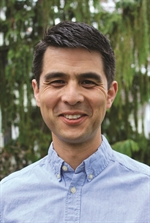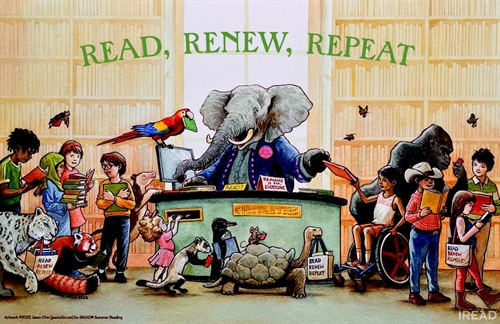September 2023 | Volume XLI, Issue 3 »
Chatting with Jason Chin
September 1, 2023
Becca Boland, Illinois Library Association

When Gretchen Schultz, the 2024 iREAD Chair, was thinking about illustrators for the theme of Read, Renew, Repeat, Jason Chin came to mind. His illustrations, like those in Island: A Story of the Galapagos and Grand Canyon, were what she envisioned when thinking about how Read, Renew, Repeat could be interpreted visually. iREAD is lucky and grateful that Jason confirmed he would be happy to be one of our illustrators on January 25, 2022, the same day he happened to win the Caldecott Medal for his illustrations in Watercress by Andrea Wang.
But the art you see now isn’t where Jason started. He went on a journey of reading, renewing, and repeating as he created. “When I got the artist brief, and it had the read, renew, repeat language on it, the first step was to start to interpret the language and try and make some connections with it and see where it led me. I came up with three concepts,” Chin shared.
The first idea was an MC Escher-like optical illusion where people were walking on stairs going in different directions in a library that was ultimately repetitive. The figures traveled using the stairs to check out books, renew them, return them, and start again.
The second concept started with Earth. “People were walking around the perimeter of the earth. You could see people walking around a circle around the outside, and at the top of the circle was the library building,” said Chin. “And some people were walking in and then other people were walking out and then walking around the globe and then back in the building.” He noted that the people were not to scale; you could clearly see them walking around the planet. There was also a similar idea where the figures around the earth were planting seeds, and as they walked, they grew and flowered–but instead of flowers, books grew.
As Jason created, he thought a lot about circles because of the cyclical nature of Read, Renew, Repeat. But eventually, he decided it would be best portrayed by zooming in. A lot. From space to the circulation desk. “Then I just thought, well, what if there were just a bunch of animals, people and animals, just at a circulation desk?” Chin said. “It was the farthest away from the initial concept. It still has that kind of flow. The poster has a left to right flow, people going past the desk.”

When adding animals, the iREAD committee suggested focusing on endangered, vulnerable, or threatened animals. But he couldn’t just add any animals–they had to be balanced and interesting to look at. This is why you see animals like the tree kangaroo instead of the natterjack toad, a fairly typical and recognizable toad found in Europe. Chin started with the larger animals and added smaller animals last. “In a crowd scene or an illustration with a lot of elements, it helps me to block in the larger components first, or in this case, animals, the larger things first,” Chin said. "So that meant kind of blocking where’s the gorilla going to go, where’s the snow leopard going to go, where’s the elephant going to be, and then working down to the kids–figuring out where they’re going to be–and then fill in the smaller animals around them. Just helps me to go in that order, to keep it organized,” Chin explained.
Essentially, that is what made this concept the one used for the poster and spot art. “Looking back at all the concepts, this one, I think, made the best poster,” stated Chin. If you look at the poster through this ‘circular’ lens, you’ll see that from left to right, there is still a cyclical nature to the art. People and animals come into the library to return books, renew if needed, and then find more books to check out, and the circle continues to repeat through the summer and beyond.
The discussion about the iREAD art led to a larger discussion about art and Chin’s creative process. Chin spends a lot of time researching before starting. If he can’t visit his subject, he watches videos, looks at photos, and reads as much as possible. Ideally, if he can, he prefers to experience it for himself–whether it is visiting the Galapagos, hiking the Grand Canyon, or standing beneath a redwood. “I always want in my books to be able to make them in a way that communicates how I feel about the place. If it’s about a place, that it communicates my enthusiasm for it or a connection to it,” said Chin.
Experiencing a place for himself translates well to the page. “When I’m illustrating, a lot of the answers to those questions come to me when I am there; or afterwards, when I’m thinking about what it felt like to be there, why it impressed me, what was special about it. To me personally, that’s always it.” He explains, “Those questions can serve as a guide to what information to include and what information to leave out at a very basic level.” It all comes down to what was most important to him and what left the biggest impression. Chin’s books gain their heart by the inclusion of his experiences and pieces of himself.
The best way for him to capture feelings and moments is to sketch them. “Sketching is important. It’s an observational tool, really,” said Chin. “Drawing can be about drawing, creating something to show people, creating art as an expression to express your ideas or feelings, or whatever. It also can be about learning. And for me, when I’m on a research trip, say, when I was at the Galapagos, drawing the animals was very much about helping me study them and spend time investigating what they look like. And since they’re living and moving about, investigating what they’re doing, drawing is an important part of that.”
Ultimately, Jason’s approach to art is circular, just like the art he created for iREAD. “Creativity is about combining things,” said Chin. “And in a painting, when I create a painting in my studio, I get to combine everything that I’ve learned about the subject. With my memories of being there, my knowledge and experience painting ideas that I have from, say, looking at someone else’s paintings of something completely different. I might look at someone’s paintings of a cityscape and think, oh, wow, I like the way that that image was composed and framed, how they framed the character. I’m going to try and incorporate, do something like that. But I’m working on the Grand Canyon because when I look at this picture of the cityscape, it makes me feel this sense of wonder. And that’s the feeling that I felt when I was at the Grand Canyon. So maybe I can combine these things and create something new. That’s the way my creative process goes.”
Chin continues,“It’s like gathering and mixing things up and seeing what comes out. And maybe, hopefully, on some level, my enthusiasm for the subject or the wonder I felt when I was there or the fear I felt of the cliff or whatever is there. That is the magic of it.” It’s these feelings and sense of wonder that he aims to incorporate into his art so that the reader can experience it as well. “If you’re not feeling something when you’re making it, then I don’t know, how can you expect the reader to feel it too? How can you ask them to go with you on this journey if you didn’t invest yourself in the journey?” said Chin.
After swimming with sharks and hiking volcanoes, I asked Chin what his dream project would be. It came as no surprise that he continues to think big. “I don’t know what a big dream project would be, but a project that could help readers see their place in the big picture history of the universe, I think that would be it. It’s a big book. It’s a big topic.”
What does Jason Chin read when he’s not working? Primarily research. Currently, he is reading books about meteorology for a new book in progress; however, he makes sure to fit in some pleasure reading. He’s a big audiobook fan. Especially when he’s working. “When I’m painting, I listen to stories. I do my fiction reading while I’m painting,” said Chin. When asked about his favorite audiobook, he replied, “I’d say the book that I like the most, definitely at the top of my list, was Braiding Sweetgrass.”
Chin would make a fabulous librarian. It is clear that research is very important to him. He spends a lot of time learning as much about a subject as possible before he begins creating art. He is very curious about the world around him and wants to take in as much of it as possible. One might deduce that his approach to creating is: research, art, repeat.
Jason Chin will be the speaker for the Youth Services Forum Author Breakfast at this year’s ILA Annual Conference in Springfield. If you’ll be attending the conference on Wednesday, October 25 and are interested in seeing Jason speak, be sure to register in advance for this special event. You can find details about the 2023 ILA Annual Conference online at ila.org/events/annual-conference. The 2024 iREAD Resource Guide, featuring Jason Chin’s art, will be available for purchase online in October at iREADprogram.org.

 iREAD Summer Reading Programs
iREAD Summer Reading Programs Latest Library JobLine Listings
Latest Library JobLine Listings